Planning a trip to Seville and wondering if you need a car? Renting a car in Seville isn’t necessary if you’re sticking to the historic centre, which is walkable and full of tapas bars, flamenco venues, and monuments.
But if you want to explore Andalusia beyond the city, a rental opens the door to unforgettable day trips: Córdoba’s winding streets, Ronda’s dramatic gorge, the wetlands of Doñana, or the iconic white villages dotting the hills. On our own trip, having a car gave us the freedom to linger at hidden viewpoints, wander quiet village lanes, and truly experience the region at our own pace.
In this guide, we’ll cover how to rent a car in Seville, what it costs, what kind of vehicle to choose, and essential tips for a smooth drive, so you can enjoy Andalusia without stress.
What You'll Find In This Post:
Do You Need a Rental Car in Seville?
Short answer: Yes—if you want to get out of the city and see the rest of Andalusia.
Seville itself is a compact, walk‑friendly treasure trove of monuments, tapas bars, and flamenco venues. For pure city sightseeing a car isn’t mandatory.
But the moment you start dreaming about day trips to Córdoba, the dramatic gorge of Ronda, the wetlands of Doñana, the sherry‑filled streets of Jerez, or the picture‑perfect white villages scattered across the hills, a rental becomes the key that unlocks those experiences.
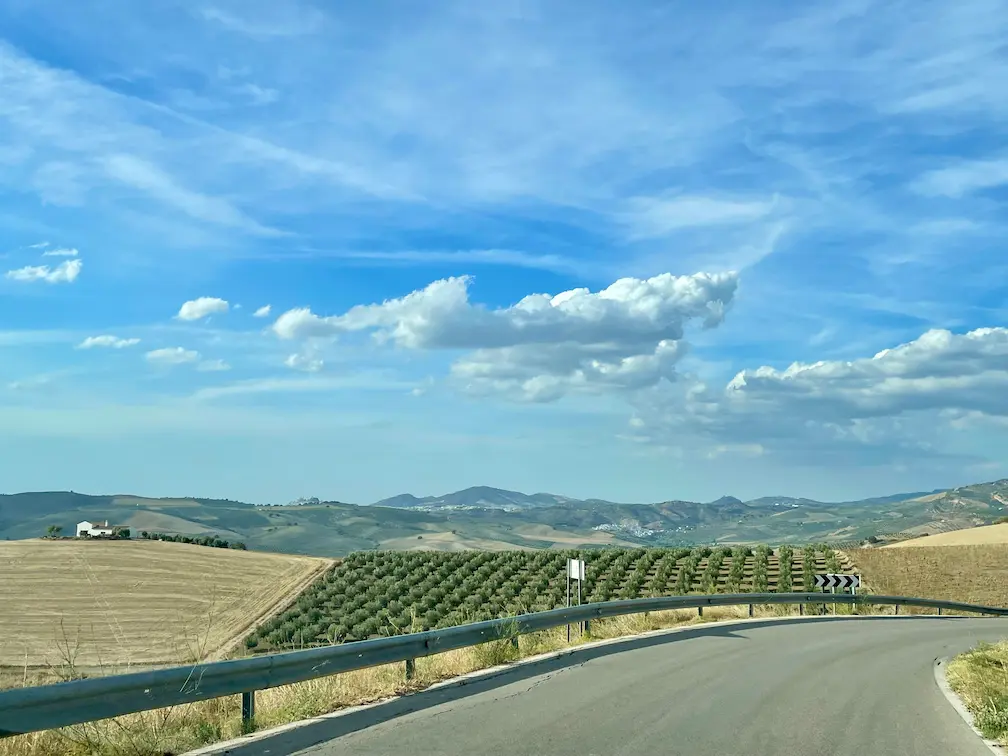
Our experience: We loved having a rental on our own Seville adventure. The city was fantastic, yet the surrounding Andalusian landscape is equally spectacular. Driving through olive groves, past centuries‑old Alcazars, and along winding mountain roads turned the journey itself into a highlight.
The freedom to pull over at a hidden vista, wander a quiet village lane, or linger for a sunset that isn’t on any timetable made the extra cost feel like an investment in unforgettable memories.
Below are the three core reasons a rental car adds genuine value to a Seville‑based holiday 👇
1. Flexibility & Time Savings
Public transport in Andalusia is reliable, but routes often demand multiple transfers and adhere to fixed timetables. With a car you set your own departure time, decide how long to linger at a site, and detour to off‑the‑beaten‑path spots without worrying about missed connections.
2. Access to Rural Treasures
Many of the region’s iconic sights—olive groves, vineyards, historic towns, and majestic Alcazars—lie outside the reach of frequent bus services. A rental lets you venture into these rural corners at your own pace, turning a simple day trip into a deeper immersion in Andalusian culture and scenery.
3. Comfort & Luggage Space
Whether you travel with a family, a group of friends, or a mountain of photography gear, a rented vehicle provides the storage and comfort that trains or buses simply can’t match. No cramped seats, no luggage fees, and no need to constantly juggle bags on crowded platforms.
Bottom line: Renting a car transforms Seville from a wonderful base into a launchpad for unforgettable Andalusian adventures—giving you flexibility, access to hidden gems, and the comfort to enjoy every mile.
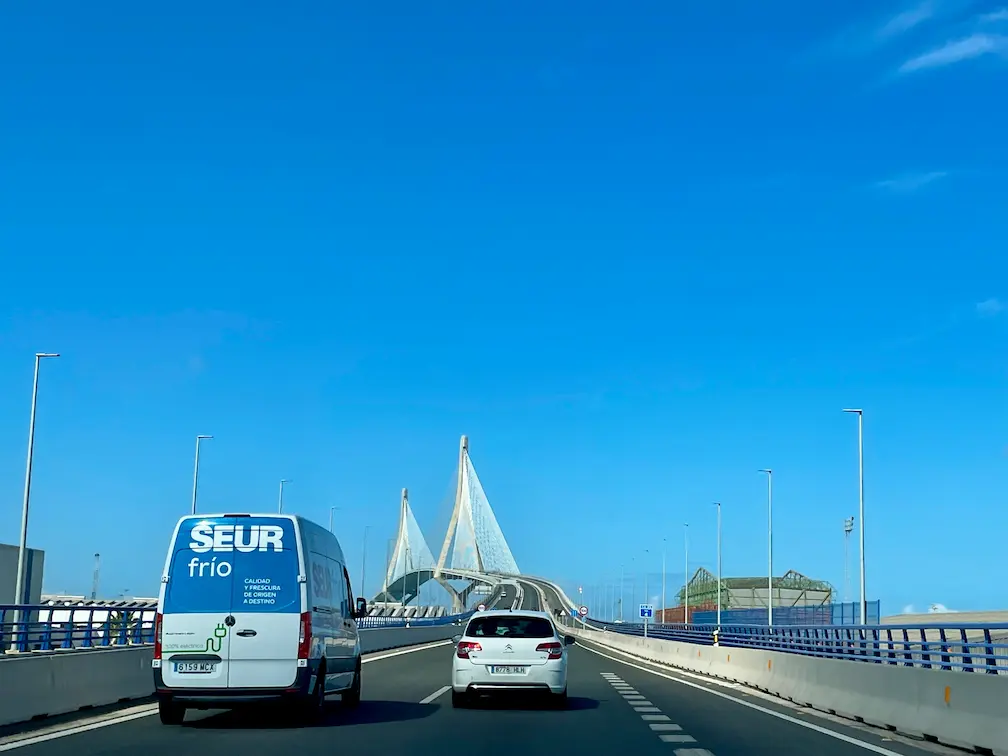
How Much Does a Rental Car Cost in Seville?
That’s probably the next question on your mind. Prices shift depending on the car class, rental company, season, and length of hire, but the figures below give you a realistic sense of what a five‑day trip will cost.
Sample Budget for a 5‑Day Trip
- Economy car (5 days) – roughly $200 (≈ €185). A small hatchback such as a Renault Clio or SEAT Ibiza is the most affordable option and fits easily into Seville’s narrow streets.
- Fuel – assuming you drive about 150 km per day at an average consumption of 7 L/100 km, you’ll spend around $70 (≈ €65).
- Insurance package (Collision‑Damage Waiver + Theft Protection) – approximately $75 (≈ €70). Many credit cards already include CDW, so double‑check before adding extra coverage.
- Miscellaneous extras – an additional driver, or a child seat typically add $30 (≈ €28).
Total estimated cost: ≈ $375 (≈ €348). Even at the higher end, a fully covered rental for five days is generally cheaper than two round‑trip train tickets plus several taxi rides between attractions.
Quick Savings Tips
- Book early – Prices rise sharply during the high‑season (May‑September).
- Use comparison aggregators – Platforms like DiscoverCars let you filter by price, vehicle type, and included insurance.
- Consider a one‑way drop‑off – If you plan to finish in Málaga, factor in the modest surcharge (≈ €30‑€60) but save the time of back‑tracking.
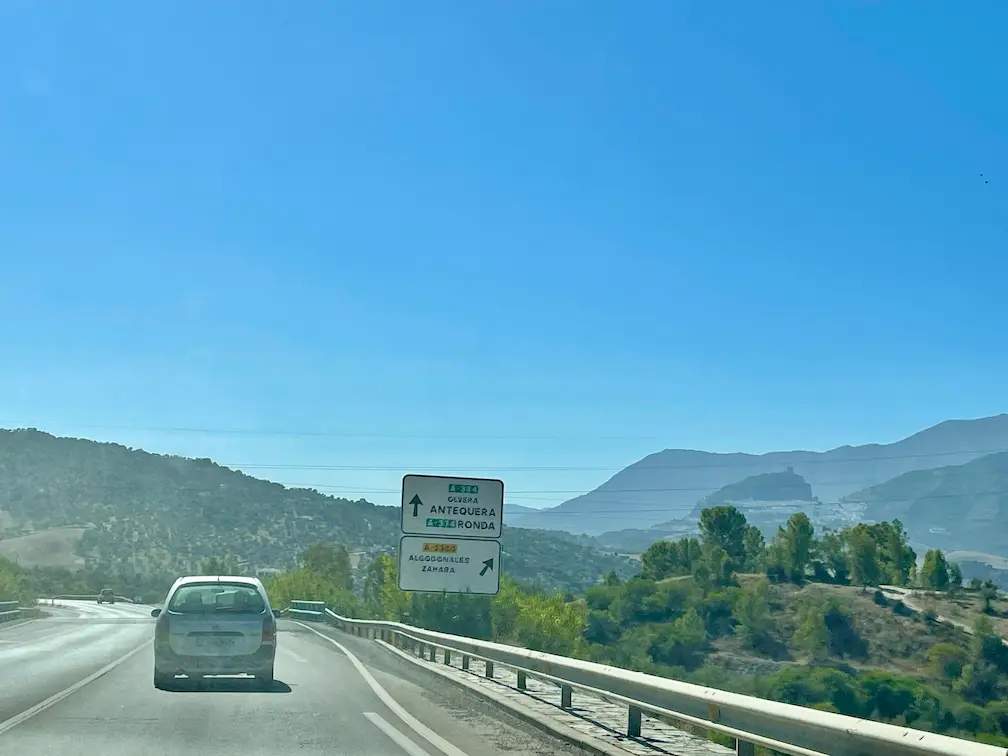
How To Choose The Right Rental Car?
Picking the ideal vehicle is the most practical decision you’ll make before hitting the road, and it hinges largely on two factors: how you’ll park and what kind of terrain you’ll tackle.
Parking vs Power
- City‑centre parking: Seville’s historic centre is a maze of narrow, cobbled streets and resident‑only zones. A compact hatchback (think Renault Clio or SEAT Ibiza) squeezes into tight spaces, reduces parking fees, and makes manoeuvring far less stressful.
- Out‑of‑town stays: If your hotel or Airbnb provides a private lot and you plan to spend most of your time outside the city centre, you have more leeway to choose a slightly larger model without worrying about cramped urban parking.
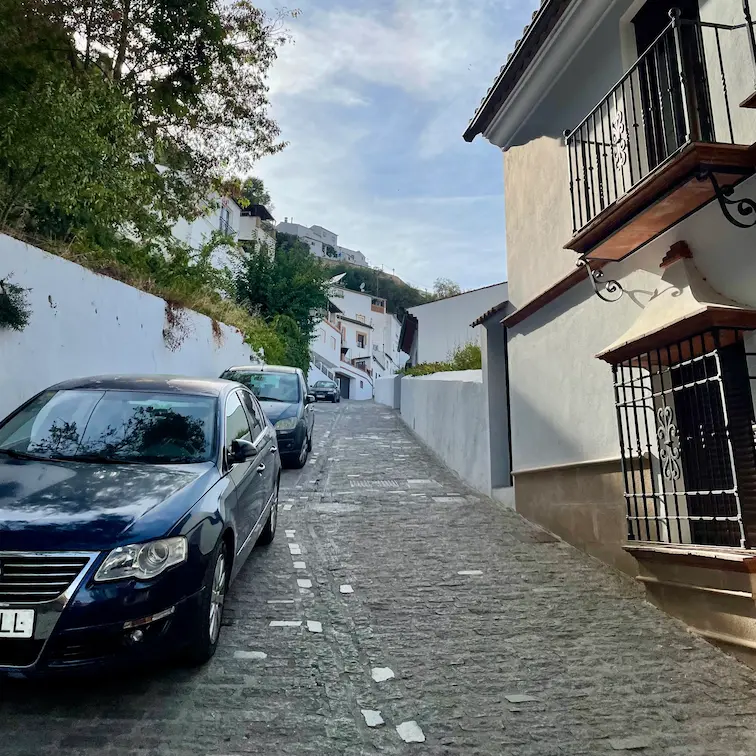
Our experience: We opted for a small economy car to keep costs low and because we were travelling light with only hand luggage. The savings on the daily rate and parking were noticeable.
However, Andalusia’s rolling hills and occasional steep climbs revealed a downside: the modest engine power of a tiny hatchback made overtaking on winding country roads a bit challenging, especially when trucks were pulling ahead.
If you anticipate a lot of hill climbing or highway passing, you might prefer a compact SUV or a midsize sedan that offers a bit more torque while still fitting into most city bays.
Quick reference guide 👇
| Travel profile | Recommended vehicle | Why it fits |
|---|---|---|
| Solo traveller / couple (light luggage) | Compact hatchback (Renault Clio, SEAT Ibiza) | Easy city parking, best fuel economy, lowest daily rate. |
| Family of four + luggage | Mid‑size sedan or compact SUV (Volkswagen Golf, Nissan Qashqai) | Extra boot space, higher driving position for better visibility on rural roads. |
| Adventure‑oriented / photography gear | Small SUV or crossover (Peugeot 3008, Kia Sportage) | More ground clearance for uneven terrain, larger cargo area for equipment. |
Bottom line: Match the car size to your parking situation and the type of roads you’ll be driving. If you’ll be mostly in Seville’s centre, go compact. If you plan extensive day trips through the hills and valleys of Andalusia, a slightly larger, more powerful vehicle will make overtaking and uphill climbs smoother, while still offering reasonable parking options on the outskirts.
Requirements for Renting a Car in Seville
- Driver’s licence – If you have an EU or EEA driver’s license, you can drive in Spain without any extra paperwork.
If you are from outside the EU (for example, the US, Canada, or Australia), you are legally required to carry an International Driving Permit (IDP) together with your original license. Many rental companies will refuse to hand over the keys without it. - Age – Most car rental companies in Seville rent to drivers 21+ years old, but some categories require you to be 23 or 25. Drivers under 25 usually pay a daily “young driver” surcharge.
You must have held your license for at least one or two years (check with the rental company). - Credit card – Required for the security deposit (typically €500‑€1,000). Some firms accept debit cards, but they may ask for extra verification.
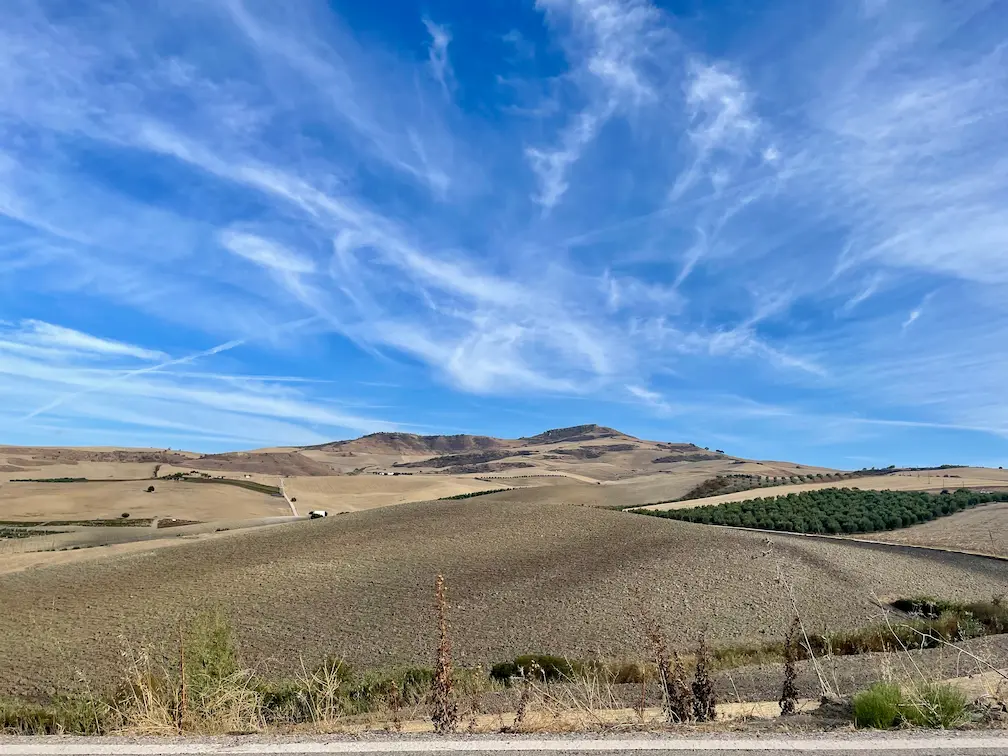
8 Essential Things To Know Before Renting a Car in Seville
1. Road Rules to Remember
- Speed limits: 50 km/h in cities, 90 km/h on secondary roads, 120 km/h on motorways.
- Seatbelts: Mandatory for all passengers.
- Phones: Hands-free only.
- Alcohol: Very low legal limit (0.05 BAC, even lower for new drivers).
2. Automatics Are Rare
Spain loves manual cars. Automatics exist, but they’re pricier and can sell out quickly. If you don’t drive stick, book your automatic car early so you’re not stuck stalling in the rental lot.
3. Fuel Policy And Gas Stations
Choose a full-to-full policy (you pick up the car full, return it full) — it’s the fairest option.
Fuel stations are plentiful in the city, but they get sparse in rural areas. If you’re heading to the countryside, top up before you leave.
4. Don’t Skimp on Insurance
Yes, basic insurance is included, but it usually comes with a pretty big deductible. Consider getting extra coverage or use a credit card that includes rental car insurance — Seville’s streets are narrow, and those little scratches can get expensive fast.
Our experience: On the second morning of our trip, we discovered a big scratch on the rear of our rental — it must have happened overnight in our hotel car park. We were so glad we had booked the full insurance (zero excess). It saved us a lot of stress and potential charges, and we could enjoy the rest of our trip worry-free.
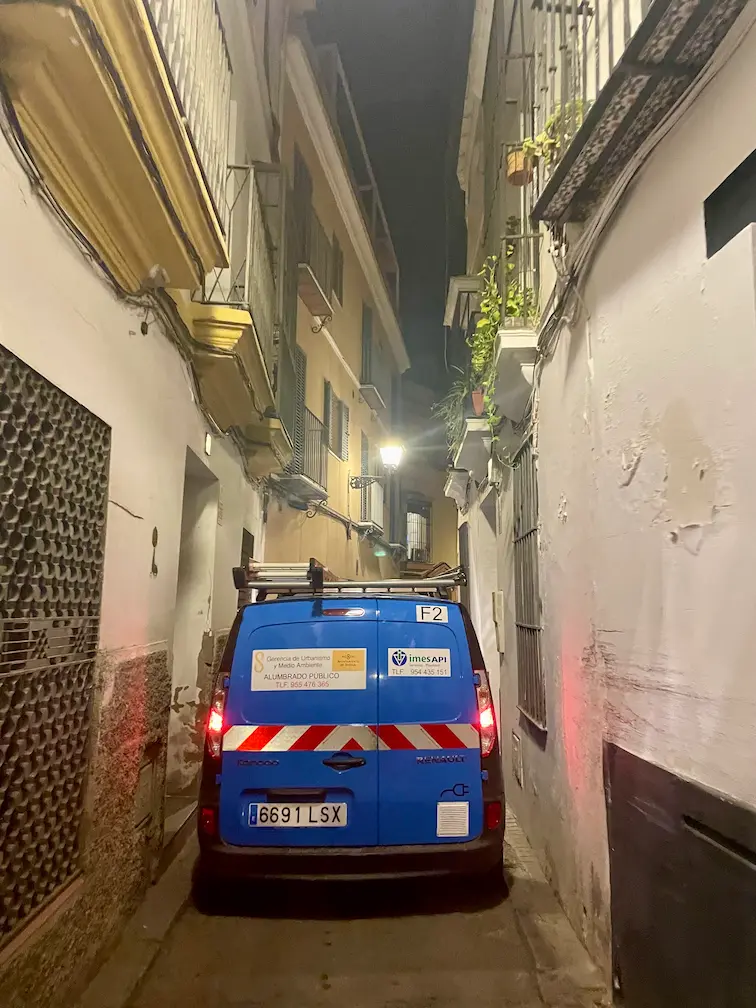
5. Driving in Seville’s Historic Centre
Seville’s old town is beautiful but tricky to drive in — narrow cobbled streets, one-way systems, and restricted zones (ZTLs) where unauthorized entry can mean a fine. Many hotels can register your plate to avoid tickets, so ask in advance.
Parking is also limited: many streets are “zona azul” (paid) or “zona verde” (residents only). The easiest option is to use a public car park such as Parking Plaza de Armas or Parking San Luis — they’re safe, central, and around €1.50 per hour.
6. Driving Etiquette
Spanish drivers can be assertive. Keep a safe distance, always use your turn signals, and be ready for the occasional last-second lane change from locals. Stay calm — and don’t be afraid to use your horn if needed (it’s not considered rude here).
7. Tolls
The good news? Most roads around Seville are toll-free. However, if you venture further afield (especially along the Costa del Sol), you may encounter toll highways such as the AP-7 or AP-46.
💡 Tip: Your GPS or Google Maps usually shows if a route has tolls and can suggest a toll-free alternative. Always check before you start your trip.
8. Pickup, Drop-off & Documentation
Take photos or a quick video of the car (inside and out) before you leave the lot. When returning it, get written confirmation that everything’s fine. This small habit can save you from surprise charges later.
Where To Book a Car in Seville?
The easiest way to find a good deal is to use a comparison site that shows prices from multiple rental companies at once. We recommend DiscoverCars — it compares top brands like Hertz, Avis, Europcar, and local agencies, so you can:
- See final prices upfront (including insurance options)
- Filter by car type, pickup location, and policy
- Get free cancellation on most bookings for peace of mind
💡 Pro Tip: Book early if you need an automatic car — they sell out quickly in Seville, especially during high season.
Conclusion
Having a rental car in Seville turned our trip from a typical city break into a true Andalusian adventure. We loved the freedom to visit olive groves, wander quiet village streets, and take spontaneous detours.
Driving through the region’s rolling hills, past centuries-old Alcazars, and along winding country roads made the journey just as memorable as the destinations. With a little planning—choosing the right car, understanding local road rules, and knowing where to park—you can enjoy every mile without stress.
If you’re dreaming of exploring Seville and beyond, a rental car isn’t just convenient—it’s the key to turning your Andalusian getaway into an unforgettable adventure.
FAQs – Renting a Car in Seville
Is it worth renting a car in Seville?
Yes—especially if you want to explore Andalusia. A car makes day trips to Córdoba, Ronda, Doñana, Jerez, and the white villages much easier. For city-only sightseeing, a car isn’t necessary.
Is driving in Seville difficult?
Seville’s historic centre has narrow, cobbled streets and limited parking, which can be tricky for new drivers. Outside the old town, main roads like the A‑4 and SE‑30 are well-signposted and easy to navigate. Most visitors find driving manageable, though parking can be the biggest challenge.
Is parking hard in Seville?
Parking in the historic centre is limited, with many streets “zona azul” (paid) or resident-only. The easiest option is public garages like Parking Plaza de Armas, Parking San Luis, or Parking Prado de San Sebastián (€1–€2/hour, daily cap €15–€20).
Do I need extra insurance when renting a car in Spain?
Base rentals include third-party liability. Additional coverage like CDW and Theft Protection is recommended for peace of mind, particularly in rural areas. Some credit cards provide CDW—check limits before declining rental insurance.
Can I rent a car in Seville and return it in Málaga?
Yes. Most rental companies offer one-way rentals between Seville (San Pablo Airport or city offices) and Málaga. Expect a surcharge of around €30–€60. Book early, specify your drop-off location, and check mileage limits.
Do I need an International Driving Permit (IDP) in Seville?
Non-EU/EEA drivers typically need an IDP along with their valid license. EU/EEA licenses are accepted without extra permits.
Are there any hidden fees when renting a car in Seville?
Check for young driver fees, one-way surcharges, extra driver costs, and GPS or child seat rentals. Reading the fine print avoids surprises.
Are toll roads common near Seville?
Most roads around Seville are toll-free. Some highways further afield, like the AP-7, may have tolls. GPS apps usually show toll routes.
You Might Also Find Interesting:
Seville highlights in 1–2 days: Visit the Alcázar, Cathedral, Plaza de España, Triana, and experience authentic tapas and flamenco shows.
Best day trips from Bilbao: beaches, fishing towns, castles, waterfalls & nature. Explore the Basque Country’s gems—all within 1–2 hours of the city.


